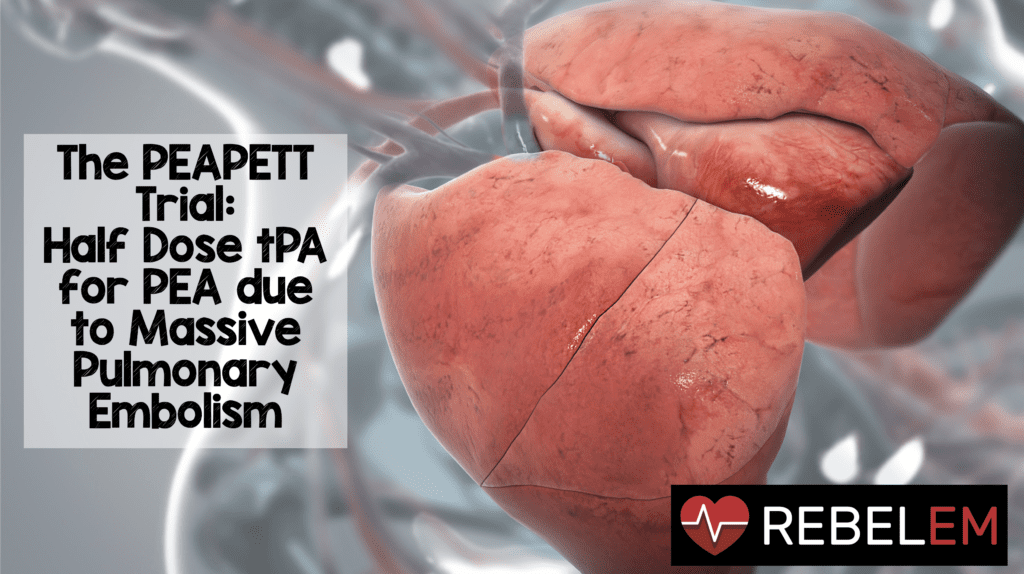
 Background: Anyone who has run a code, knows that pulseless electrical activity (PEA) during cardiac arrest has a worse prognosis compared to patients with shockable rhythms. In patients with suspected massive PE as the cause of their cardiac arrest the Advanced Cardiac Life Support (ACLS) and American Heart Association (AHA) guidelines do recommend consideration of thrombolytics. There is however, no uniform consensus on the type, dose, duration, timing, or method of administration. The current study (PEAPETT Trial) was an attempt to do exactly that.
Background: Anyone who has run a code, knows that pulseless electrical activity (PEA) during cardiac arrest has a worse prognosis compared to patients with shockable rhythms. In patients with suspected massive PE as the cause of their cardiac arrest the Advanced Cardiac Life Support (ACLS) and American Heart Association (AHA) guidelines do recommend consideration of thrombolytics. There is however, no uniform consensus on the type, dose, duration, timing, or method of administration. The current study (PEAPETT Trial) was an attempt to do exactly that.
What They Did:
- Single Center, Case Series
- 23 patients with PEA and cardiopulmonary arrest due to confirmed massive PE
- All patients received 50mg of tPA as intravenous push over 1 minute
- Subsequently, patients were given between 2000 – 5000 Units of heparin as a bolus and then started on an initial maintenance drip of 10U/kg/hr
Outcomes:
- ROSC
- Survival to Hospital Discharge
- Major and Minor Bleeding
- At 48 Hours:
- RV/LV Ratio on Echocardiography
- Pulmonary Artery Systolic Pressure on Echocardiography
Results:
- Return of Spontaneous Circulation (ROSC) occurred in 2 – 15 minutes after tPA administration in all but 1 patient (22/23 patients)
- No minor or major bleeding
- 2/23 died in the hospital
- 20/23 patients (87%) still alive at 22 +/- 3 months of follow-up
- RV/LV ratio and pulmonary artery systolic pressure dropped from:
- 79 +/- 0.27 and 58.10 +/- 7.99 mmHg on admission to
- 16 +/- 0.13 and 40.25 +/- 4.33 mmHg within 48 hours respectively
Strengths:
- First study to evaluate the use of half dose tPA for patients with PEA arrest due to confirmed PE
Limitations:
- Single Center, Case Series
- Although patients were followed in a prospective fashion this was truly a retrospective study as results were obtained from chart review
- There were no control groups
- We don’t have neurologic outcomes for all patients (although “all surviving patients reported a return to before event functional capacity without any restrictions which could be attributed to PE.”)
Discussion:
- Time to administration of tPA from initiation of CPR was 6.5 +/- 2.1minutes (This is pretty fast, when you think about making the diagnosis and drawing up the medication)
- 16 of 23 patients had PE diagnosed by CTPA prior to arrest while only 3 were diagnosed intrarrest with evidence of thrombus in the right ventricle via ultrasound
- The AHA gives a grade IIa recommendation for administration of thrombolytic therapy for cardiac arrest due to PE
- There is conflicting literature on using tPA in undifferentiated PEA
Author Conclusion: “Rapid administration of 50mg of tPA is safe and effective in restoration of spontaneous circulation in PEA due to massive PE leading to enhanced survival and significant reduction in pulmonary artery pressures.”
Clinical Take Home Point: Although this is not the most robust evidence, it would be reasonable to consider giving 50mg IV tPA in patients with suspected or confirmed PE causing cardiac arrest.
References:
- Sharifi M et al. Pulseless Electrical Activity in Pulmonary Embolism Treated with Thrombolysis (from the “PEAPETT” study). American Journal of Emergency Medicine 2016; 34: 1963 – 1967. PMID: 27422214
For More Thoughts on This Topic Checkout:
- Scott Weingart at EMCrit: Podcast 143 – Hemodynamic Management of Massive Pulmonary Embolism (PE)
- Josh Farkas at EMCrit (Pulmcrit): Eight Pearls for the Crashing Patient with Massive PE
Post Peer Reviewed By: Matt Astin (Twitter: @mastinmd)
The post The PEAPETT Trial: Half Dose tPA for PEA due to Massive Pulmonary Embolism appeared first on REBEL EM - Emergency Medicine Blog.
